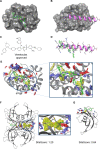Current Challenges and Opportunities in Designing Protein-Protein Interaction Targeted Drugs
- PMID: 33209039
- PMCID: PMC7669531
- DOI: 10.2147/AABC.S235542
Current Challenges and Opportunities in Designing Protein-Protein Interaction Targeted Drugs
Abstract
It has been noticed that the efficiency of drug development has been decreasing in the past few decades. To overcome the situation, protein-protein interactions (PPIs) have been identified as new drug targets as early as 2000. PPIs are more abundant in human cells than single proteins and play numerous important roles in cellular processes including diseases. However, PPIs have very different physicochemical features from the conventional drug targets, which make targeting PPIs challenging. Therefore, as of now, only a small number of PPI inhibitors have been approved or progressed to a stage of clinical trial. In this article, we first overview previous works that analyzed differences between PPIs with PPI targeting ligands and conventional drugs with their binding pockets. Then, we constructed an up-to-date list of PPI targeting drugs that have been approved or are currently under clinical trial and have bound drug-target structures available. Using the dataset, we analyzed the PPIs and their ligands using several scores of druggability. Druggability scores showed that PPI sites and their drugs targeting PPIs are less druggable than conventional binding pockets and drugs, which also indicates that PPI drugs do not follow the conventional rules for drug design, such as Lipinski's rule of five. Our analyses suggest that developing a new rule would be beneficial for guiding PPI-drug discovery.
Keywords: PPI; PPI drugs; drug discovery; protein–protein interaction.
© 2020 Shin et al.
Conflict of interest statement
The authors report no conflicts of interest in this work.
Figures




References
Publication types
Grants and funding
LinkOut - more resources
Full Text Sources
Other Literature Sources
Miscellaneous

